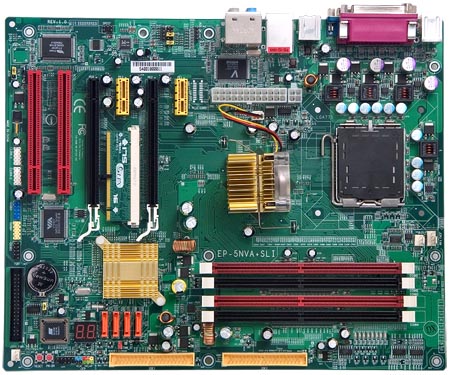 |
||
|
||
| ||
Motherboards from EPoX haven't been reviewed on our web site for a long time already. And finally it has happened! The EPoX 5NVA SLI motherboard is based on the top nForce4 SLI (IE) chipset and possesses a standard, but sufficient set of functions to qualify for a top motherboard. It's the second motherboard on nForce4 (IE) that we are going to test (the first one was MSI P4N Diamond). So, what do we have here? Quite a nice box, a rich (without excesses, though) bundle, and a set of LEDs, which are not harsh to your eyes, but still provide necessary information whether the motherboard operates correctly — these are all exterior peculiarities of the product under review. The EPoX 5NVA SLI cannot boast of rich functionality, but it still possesses the set of functions, which will be used by nearly all users to the full extent. Here lies one positive point: the new model from EPoX is not oversaturated with useless bells and whistles, which functions can be only guessed about in everyday life. Good quality (for an AC’97 codec) of the integrated audio solution, 1 GB/s network PHY, and a FireWire controller with two IEEE 1394a ports — these are all the 5NVA SLI can boast of. The only disappointment is the lack of "non-chipset" HDD controllers. But in fact, the main advantage of this motherboard, obtained together with the chipset, is SLI - note two PCIE x16 ports (one of them operates in x16/x8 modes, the other - x8/x1). A special board is used to switch between the regular mode and the SLI mode, which is not very convenient (for example, the MSI P4N Diamond allows to do it on the software level, i.e. in BIOS).
 Expert PCB layout produces a nice impression. The only gripe we have is a bad layout of connectors for brackets with additional USB and WiFi ports — they are right behind the last PCI slot, which may cause inconveniences, if a large expansion card is installed into it. The motherboard is equipped with the following elements: POST code display in the form of two seven-segment LEDs and a set of LEDs that indicate chipset, memory, and processor operations (they are blue, if everything is OK; if not, they are not lit at all =)). A fan on the northbridge heatsink is installed vertically. EPoX probably starts implementing some of its BTX ideas to manage air flows inside a PC case. The 4-phase switching voltage regulator of the processor incorporates ten 560 uF capacitors and four 330 uF capacitors. The board also contains a memory voltage regulator (two 3300 uF capacitors and four 1000 uF ones.) The motherboard has no empty seats for unsoldered elements. Motherboard dimensions 305x245 mm ("wide" ATX, ten-screw mount, all motherboard edges are firmly fixed). System monitoring (Fintek F71872F LPC):
Onboard ports, sockets, and connectors
Back panel (left to right, blockwise) Click the image to open the rear view of this motherboard
Package Contents
Integrated Controllers
The integrated audio quality was tested in 16bit, 44 kHz using the RightMark
Audio Analyzer 5.5 test application and the Terratec
DMX 6fire sound card:
General performance: Good (Details). Settings
We used BIOS dated 05.22.2005, the latest available BIOS version at the time of our tests. The mentioned BIOS parameters are available in this version, but the viability of non-standard settings hasn't been tested. PerformanceTestbed configurations:
As we have tested only two motherboards on nForce4 SLI (IE) so far, it's hard to draw an objective conclusion about the performance of motherboards on this core logic. The table below contains results of the Epox 5NVA SLI and the MSI P4N Diamond, mentioned in the beginning of the article. The motherboard under review is a tad faster than the MSI model on the same chipset, you can see it with the naked eye.
That's all we can tell you about motherboards on the new core logic from nVidia so far. Well, our lab will be looking forward to new representatives of this chipset in order to determine the fastest, the most reliable, the most functional, and the best bundled model. Look forward to a large roundup!
This model on the manufacturer's web site The motherboard is kindly provided by the manufacturer
Write a comment below. No registration needed!
|
Platform · Video · Multimedia · Mobile · Other || About us & Privacy policy · Twitter · Facebook Copyright © Byrds Research & Publishing, Ltd., 1997–2011. All rights reserved. | |||||||||||||||||||||||||||||||||||||||||||||||||||||||||||||||||||||||||||||||||||||||||||||||||||||||||||||||||||||||||||||||||